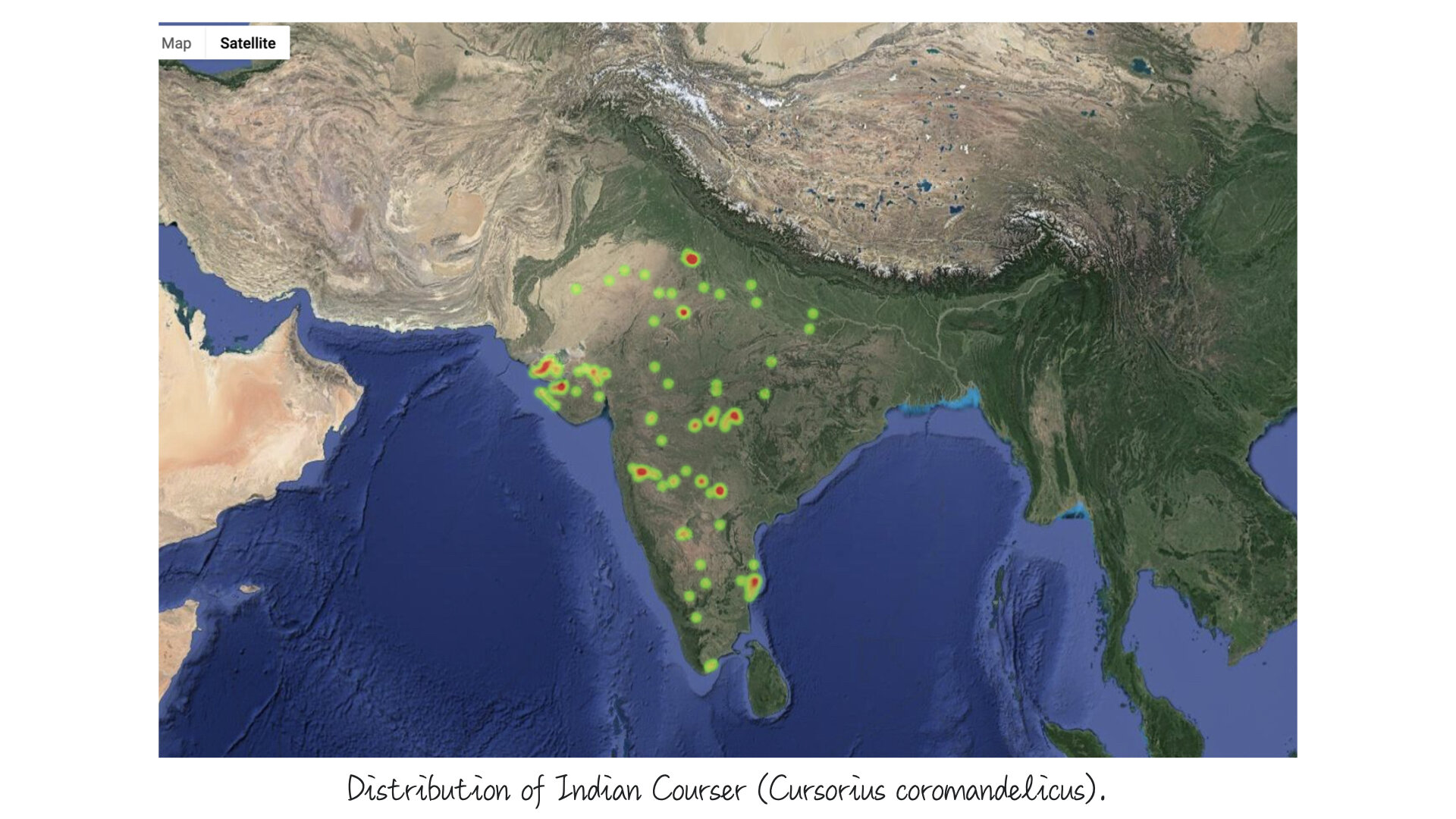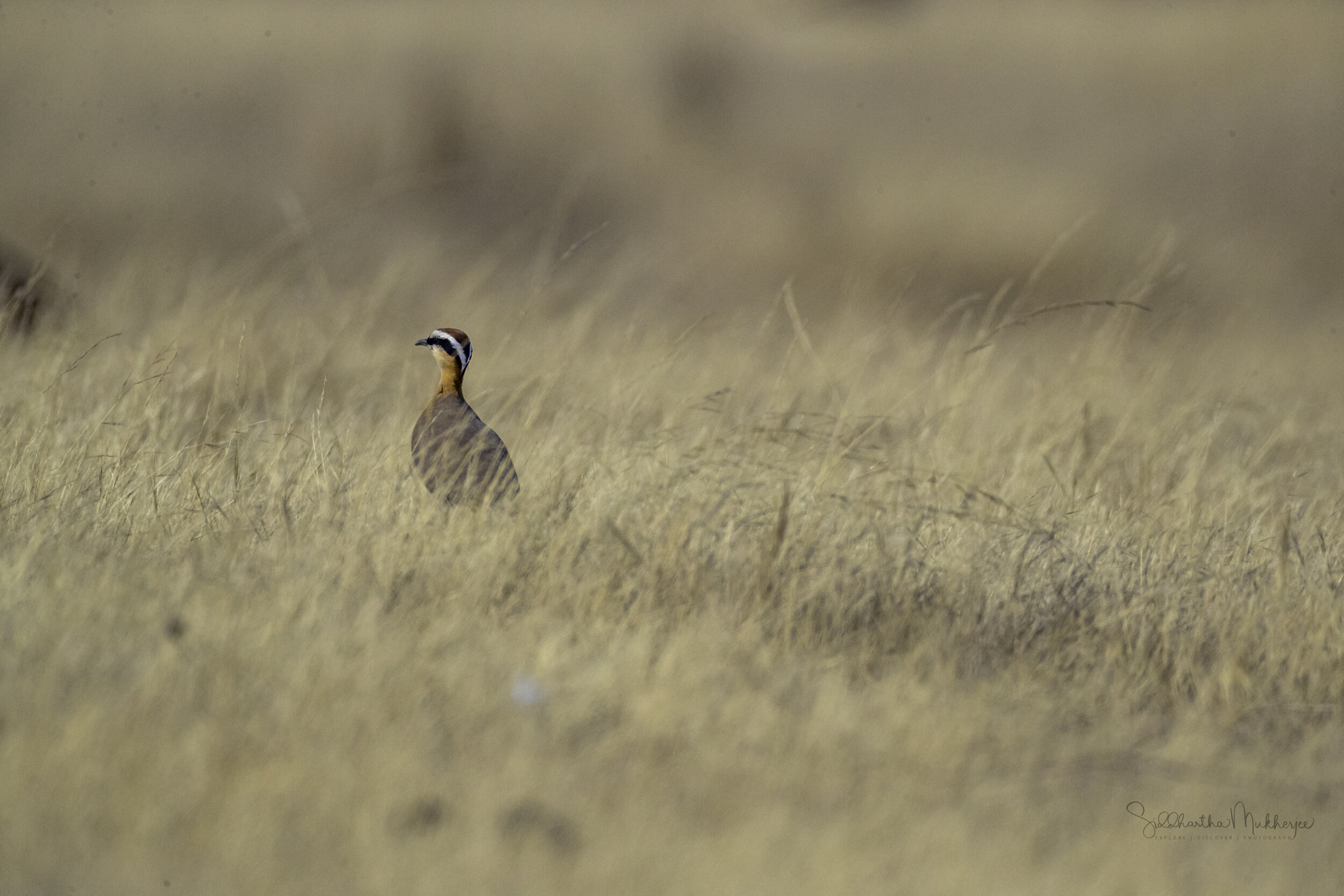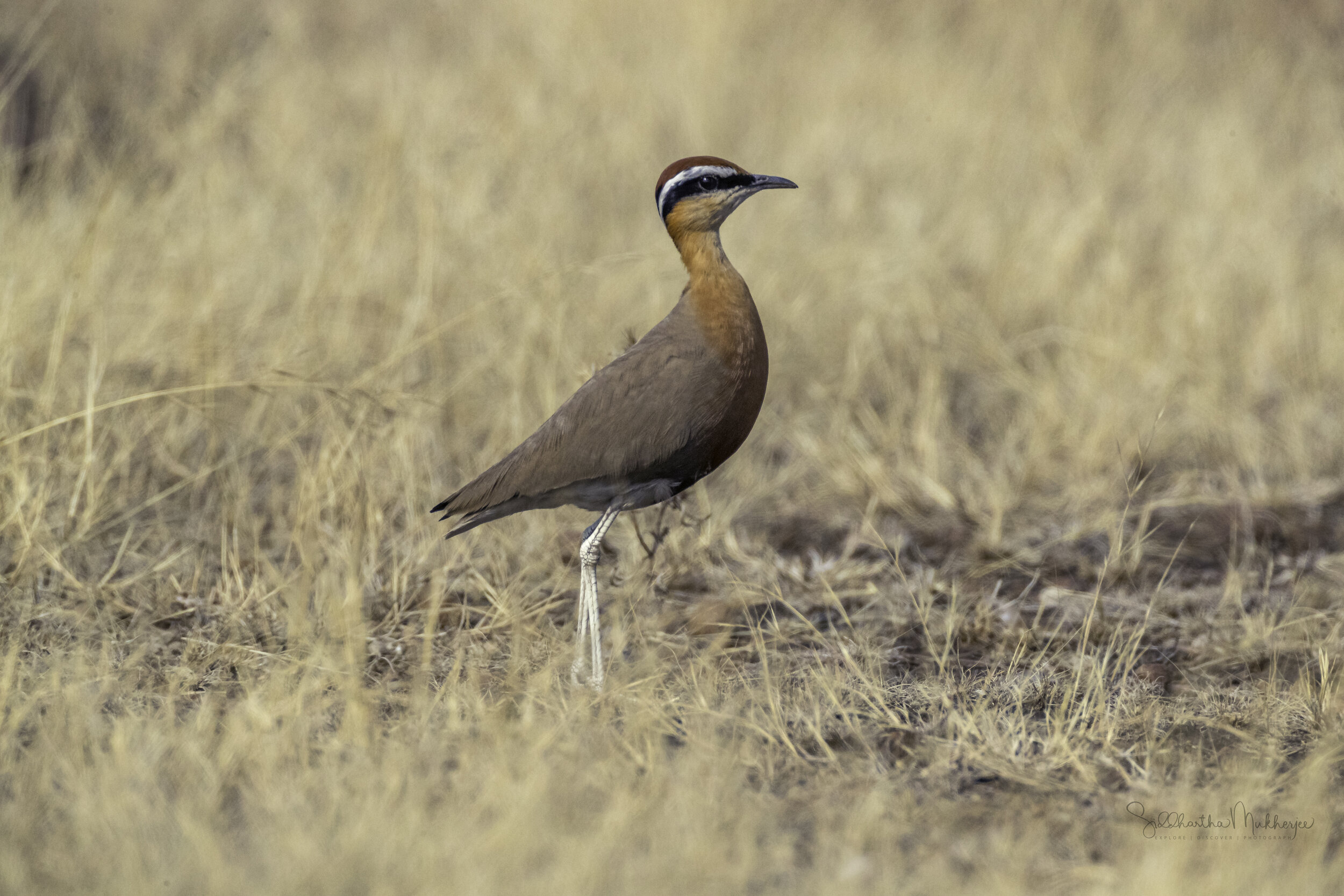Indian Courser
Cursorius coromandelicus
NEAR THREATENED
Grasslands in Telangana & the Bhigwan Bird Sanctuary
Update - 13 September 2025:
The Indian Courser (Cursorius coromandelicus) has been moved to the ‘Near Threatened’ category on the IUCN Red List highlighting the shrinking grasslands and agricultural lands in India. The species has most recently been assessed for The IUCN Red List of Threatened Species in May 2025 and its status has been updated to Near Threatened under criteria A2bce+4bce.
Notably, all four species - the Indian Courser, Rufous-tailed Lark, Indian Roller & the Long-billed Grasshopper-warbler - that have been uplisted depend upon open natural ecosystems, which include habitats like grasslands, semi-arid landscapes, desert, croplands, hilly scrublands, and fallow lands. These ecosystems have been under pressure from the expansion of power infrastructure, intensification of agriculture, introduction of invasive species, and interestingly, conversion into woodlands through afforestation.The decline of bird species that rely on these ecosystems highlights the critical need to conserve such open habitats.
Conservation must extend beyond protected areas and embrace coordinated efforts across agencies to safeguard birds surviving in human-dominated landscapes.
*****
Surrounding the lush ecosystem of the Ujni backwaters in Maharashtra are the rich grasslands and fertile farms home to an impressive list of birds, mammals and reptiles like the Indian courser - featured here, Chestnut-bellied Sandgrouse, Blue-cheeked Bee-eater, Grey Francolin, Woolly-necked Stork, and Demoiselle Cranes. The Indian Chameleon is often seen here and after dark, creatures of the night like the Leopard Gecko and Termite Hill Gecko are out and about. Although rare, the Common Sand Boa, rat snake, and Russell’s viper are also spotted. The open areas around the villages host mammals like the Black-naped Hare, Jungle Cat, Golden Jackal, and Indian Grey Mongoose. The Asian Palm Civet can also be seen, especially at night. The extensive grasslands protect many mammals like the Chinkara, Hyena, Wolf and Indian Fox. It is also popular for grassland birds and the birds of prey, including the Steppe Eagle and the rare Imperial Eagle. While largely unnoticed, frogs, toads, damselflies, dragonflies, beetles, and scorpions also inhabit the area. A study published by the Zoological Survey of India in 2002 reported 54 species of fish.
I spent a couple of days with some friends in Kumbhargaon village, the winter home for an immense variety of birds like Greater Flamingos, Gray Herons, Painted Storks, Brown Headed Gulls, River Terns & Little Terns, the Black-headed & Red-naped Ibis, Little Ringed Plover, Osprey and the Peregrine Falcon to name a few.
While searching for the Eastern Imperial Eagle in the Shirsuphal grasslands we came across the beautiful Indian Courser. This elegant and stately large plover-like bird has an erect posture, a strong black-and-white brow pattern, an orange-suffused crown and chest, and a slightly down curved dark bill. This graceful bird inhabits dry open spaces, including rocky plains and arid areas with scattered scrubs and gathers in small flocks outside of the breeding season.
During our time here we were hosted by and had the expert help of Sandip Nagare and his team of knowledgeable guides from the Agnipankha Bird Watcher group, especially Ganesh Bhoi, who went out of their way to ensure we had fantastic opportunities to explore, discover, observe & photograph over 82 species of birds and wildlife including some rare ones. We stayed at Sandip’s homestay of the same name and had the added pleasure of indulging in delectable home cooked food.
‡‡‡‡‡
Indian Courser
The Indian Courser (Cursorius coromandelicus) is a species of courser found in mainland South Asia, mainly in the plains bounded by the Ganges and Indus river system. Like other coursers, it is a ground bird that can be found in small groups as they forage for insects in dry open semi-desert country.
It is widespread in South Asia and is brighter in colour than the cream-coloured courser with broader black eye-stripe that begins at the base of the beak. The crown is chestnut and the breast is rufous and the nape has a dark black patch where the long longer feathers forming the white stripe meet. In flight, the rump appears white and the wing tip is not as contrastingly black as in the cream-coloured courser. The sexes look alike. Their long legs are whitish and as in other coursers have only three forward pointing toes.
These birds are usually seen in small flocks and found where the grass is not taller than them, since the tall grass blocks their view.
This species has an extremely large range, and hence does not approach the thresholds for Vulnerable under the range size criterion (Extent of Occurrence <20,000 km2 combined with a declining or fluctuating range size, habitat extent/quality, or population size and a small number of locations or severe fragmentation). The population trend appears to be stable and the population size is not believed to approach the thresholds for Vulnerable. Therefore the species is evaluated as Least Concern. Apparently still fairly common over most of range, but listed as Critically Endangered in Sri Lanka and declines have been reported in several areas as a result of uncultivated grasslands at the hands of increasing agricultural and spread of settlements; it is able to survive even in regions where grazing livestock, jackals, dogs and crows are plentiful, so unlikely to suffer severe decrease in numbers in short or medium term.
They forage for Beetles and their larvae, grasshoppers, mole crickets and other insects, such as ants; small molluscs. It catches insects by running in short fast spurts, stopping and dipping forward to peck at the ground. They are occasionally observed in sizeable flocks, more usually 5–10 individuals in post-breeding season, and occasionally associated with C. cursor.
The bird is generally considered to be rather quiet and gives a hoarse, creaky “gwaat” or “wut” on flushing, becoming more subdued with repetition
The arid and open habitats used by the Indian courser are threatened by human activities such as construction and agriculture. In parts of states like Gujarat, the species was very common in short-grass covered open and fallow lands but has vanished in many areas. In some areas, vehicular activity and industrialization have destroyed habitats where they formerly occurred. Unfortunately even here in Bhigwan and its surrounding grasslands the vehicular traffic through these threatened grasslands is increasing as more and more bird and wildlife enthusiasts chase the birds for their photographs. We are concerned about the animals and birds disappearing but it is also the habitat that is threatened. Especially these fast disappearing Deccan thorn scrub forests and grasslands. Read more about these here and here for if the habitat disappears so do the birds and animals.
‡‡‡‡‡
The following are some photos and a video of the Indian Courser we accidentally encountered in the beautiful grasslands of Shirsuphal some distance to the north of Bhigwan. The time spent watching these coursers was beautiful and a far cry from the excitement of spotting the giant eagles. The coursers went about their business as normal and paid no attention to us and some even came very close to our vehicle as we waited and watched in silence.
The following footage was recorded on 12th February on the grasslands near Shirsupal at the Bhigwan Bird Sanctuary.
Related Posts

























